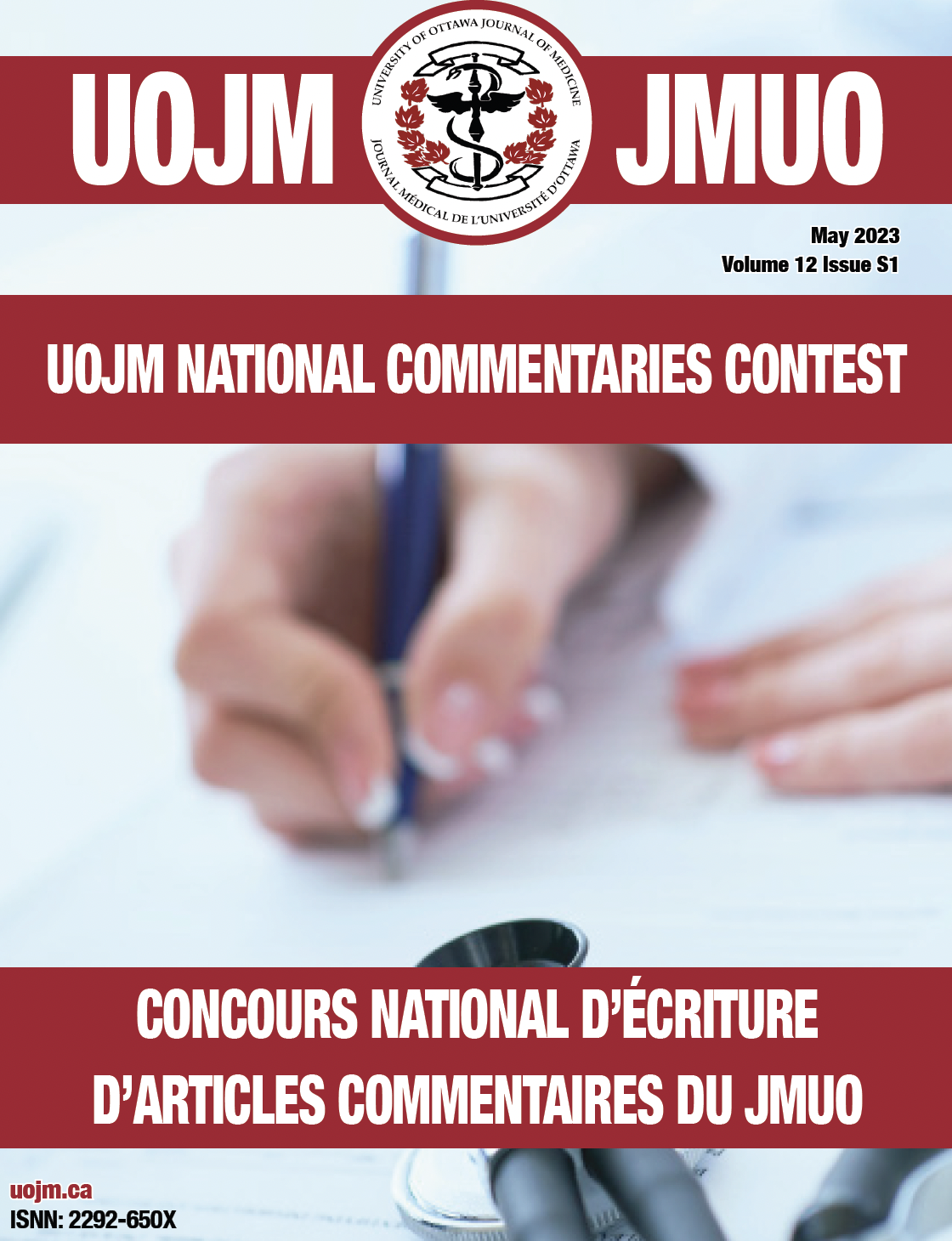Les études médicales postdoctorales: un appel au changement
DOI:
https://doi.org/10.18192/uojm.v13iS1.6570Keywords:
Medical Education, Residency, BurnoutReferences
References
Ahmed, N., Devitt, K. S., Keshet, I., Spicer, J., Imrie, K., Feldman, L., Cools-Lartigue, J., Kayssi, A., Lipsman, N., Elmi, M., Kulkarni, A. V., Parshuram, C., Mainprize, T., Warren, R. J., Fata, P., Gorman, M. S., Feinberg, S., & Rutka, J. (2014). A systematic review of the effects of resident duty hour restrictions in surgery: impact on resident wellness, training, and patient outcomes. Annals of surgery, 259(6), 1041–1053. https://doi.org/10.1097/SLA.0000000000000595
Mauser, N. S., Michelson, J. D., Gissel, H., Henderson, C., & Mauffrey, C. (2016). Work-hour restrictions and orthopaedic resident education: a systematic review. International orthopaedics, 40(5), 865–873. https://doi.org/10.1007/s00264-015-3045-7
Bolster, L., & Rourke, L. (2015). The Effect of Restricting Residents' Duty Hours on Patient Safety, Resident Well-Being, and Resident Education: An Updated Systematic Review. Journal of graduate medical education, 7(3), 349–363. https://doi.org/10.4300/JGME-D-14-00612.1
Kogan, J. R., Lapin, J., Aagaard, E., Boscardin, C., Aiyer, M. K., Cayea, D., Cifu, A., Diemer, G., Durning, S., Elnicki, M., Fazio, S. B., Khan, A. R., Lang, V. J., Mintz, M., Nixon, L. J., Paauw, D., Torre, D. M., & Hauer, K. E. (2015). The effect of resident duty-hours restrictions on internal medicine clerkship experiences: surveys of medical students and clerkship directors. Teaching and learning in medicine, 27(1), 37–50. https://doi.org/10.1080/10401334.2014.979187
Garg, M., Drolet, B. C., Tammaro, D., & Fischer, S. A. (2014). Resident duty hours: a survey of internal medicine program directors. Journal of general internal medicine, 29(10), 1349–1354. https://doi.org/10.1007/s11606-014-2912-z
Harris, J. D., Staheli, G., LeClere, L., Andersone, D., & McCormick, F. (2015). What effects have resident work-hour changes had on education, quality of life, and safety? A systematic review. Clinical orthopaedics and related research, 473(5), 1600–1608. https://doi.org/10.1007/s11999-014-3968-0
Lee M. J. (2015). On Patient Safety: Have The ACGME Resident Work Hour Reforms Improved Patient Safety?. Clinical orthopaedics and related research, 473(11), 3364–3367. https://doi.org/10.1007/s11999-015-4547-8
Schattner A. (2022). The Spectrum of Harm Associated with Modern Medicine. Journal of general internal medicine, 37(3), 664–667. https://doi.org/10.1007/s11606-021-06997-x
Hewett M. (2022). Ethics and toxic high-workload work environments. The British journal of general practice : the journal of the Royal College of General Practitioners, 72(718), 226–227. https://doi.org/10.3399/bjgp22X719333
Ten Cate O. (2017). Snell L, Frank JR, Sherbino J. CanMEDS 2015 Physician Competency Framework. Ottawa, Canada: Royal College of Physicians & Surgeons of Canada; 2015.
Binnendyk, J., Pack, R., Field, E., & Watling, C. (2021). Not wanted on the voyage: highlighting intrinsic CanMEDS gaps in Competence by Design curricula. Canadian medical education journal, 12(4), 39–47. https://doi.org/10.36834/cmej.70950
Mamykina, L., Vawdrey, D. K., & Hripcsak, G. (2016). How Do Residents Spend Their Shift Time? A Time and Motion Study With a Particular Focus on the Use of Computers. Academic medicine : journal of the Association of American Medical Colleges, 91(6), 827–832. https://doi.org/10.1097/ACM.0000000000001148
Gaston-Hawkins, L. A., Solorio, F. A., Chao, G. F., & Green, C. R. (2020). The Silent Epidemic: Causes and Consequences of Medical Learner Burnout. Current psychiatry reports, 22(12), 86. https://doi.org/10.1007/s11920-020-01211-x
Vasquez, T. S., Close, J., & Bylund, C. L. (2021). Skills-Based Programs Used to Reduce Physician Burnout in Graduate Medical Education: A Systematic Review. Journal of graduate medical education, 13(4), 471–489. https://doi.org/10.4300/JGME-D-20-01433.1
Hipp, D. M., Rialon, K. L., Nevel, K., Kothari, A. N., & Jardine, L. (2017). "Back to Bedside": Residents' and Fellows' Perspectives on Finding Meaning in Work. Journal of graduate medical education, 9(2), 269–273. https://doi.org/10.4300/JGME-D-17-00136.1
Downloads
Published
Issue
Section
License
Copyright (c) 2022 Laurent Dubé

This work is licensed under a Creative Commons Attribution-NonCommercial-NoDerivatives 4.0 International License.
- Authors publishing in the UOJM retain copyright of their articles, including all the drafts and the final published version in the journal.
- While UOJM does not retain any rights to the articles submitted, by agreeing to publish in UOJM, authors are granting the journal right of first publication and distribution rights of their articles.
- Authors are free to submit their works to other publications, including journals, institutional repositories or books, with an acknowledgment of its initial publication in UOJM.
- Copies of UOJM are distributed both in print and online, and all materials will be publicly available online. The journal holds no legal responsibility as to how these materials will be used by the public.
- Please ensure that all authors, co-authors and investigators have read and agree to these terms.
- Works are licensed under a Creative Commons Attribution-NonCommercial-NoDerivatives 4.0 International License.


